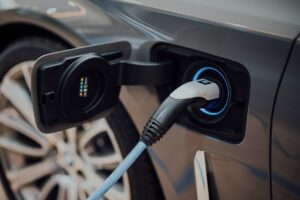Electromobility is becoming increasingly important. The right charging infrastructure is a decisive factor in ensuring the efficient and reliable use of commercial electric vehicles. In this article, we explain the most important terms relating to charging and which aspects you should pay attention to.
Contents
What is a charging infrastructure for electromobility?
The charging infrastructure includes all facilities and equipment required for charging electric vehicles. This includes charging stations, charging cables, energy distribution systems and grid connections. Charging infrastructure can be installed both on company premises and in public spaces. A photovoltaic system can also be considered part of the infrastructure.
Which charging station? Charging station or wallbox
Charging stations often offer not only alternating current, but also direct current (DC). This significantly increases the charging capacity and shortens the charging time. When charging at 50 kW, the storage unit reaches its full capacity of 100 percent much faster. Wallboxes are also suitable for installation at the driver’s home. Compared to a household socket, the wallbox charges the electric car up to ten times faster. The charging power is usually 11 kW or 22 kW. Mobile charging stations are a type of adapter that allows you to charge up to ten times faster on the move than at a normal household socket.
What does AC or DC charging mean?
Charging with alternating current (AC):
- Gentle and widely used
Alternating current (AC) is the most common type of electricity that comes out of most sockets. The charging process is slower, but the battery is less stressed. A charger is required on board – often a type 2 plug that converts the alternating current into direct current. The charging capacity is therefore limited and is usually between 3 kW and 16 kW per hour. Another advantage of AC charging is the widespread availability of AC charging stations in many public places, shopping centers and parking lots.
Direct current (DC) charging:
- Fast and efficient
With direct current charging, the alternating current is already converted into direct current at the charging station. This enables a significantly higher charging capacity. Fast-charging stations at filling stations and fast-charging stations can fully charge the battery of an electric vehicle in just 10 to 20 minutes. The CCS (Combined Charging System) plug required for this supports charging capacities of up to 350 kW. Frequent charging with direct current can affect the service life of the battery. It should therefore only be used when necessary and not as the standard charging method.

Advantages of a company-owned charging infrastructure
- Cost savings: A well-developed charging infrastructure with intelligent charging management optimizes charging times and reduces energy costs. Public charging stations cost 35 to 70 cents per kWh. Companies also benefit from tax incentives and funding programs that support the development of charging infrastructure.
- Image and sustainability: electromobility helps to reduce emissions and enables companies to position themselves as pioneers in terms of sustainability.
- Employer attractiveness: The provision of charging infrastructure for electric vehicles can be a decisive factor in attracting and retaining skilled workers. More and more employees are attaching importance to environmentally friendly workplace solutions. In addition, employees can charge their cars tax-free at the company.
- Flexibility and fleet management: With their own charging infrastructure, companies have the charging of their electric vehicles in their own hands. This enables flexible planning of fleet activities and optimized route planning. By using intelligent charging management systems, companies can monitor the charging process remotely and adjust charging capacities as required.
- Additional source of income: A charging infrastructure can also become an additional source of income for companies. By opening up their charging stations for public use, companies can charge fees for charging and thus amortize the costs of the infrastructure. However, public charging stations must comply with calibration law.
What does an electric mobility charging infrastructure cost?
The costs for setting up a charging infrastructure in a company vary depending on the installation effort, the number and type of charging stations and the electricity costs. The installation costs include the cabling and adaptations to the existing infrastructure, including approval and, if applicable, construction costs. Consultancy costs may also be incurred. The prices for charging stations vary depending on the model and function. Added to this are the electricity costs for operating the charging infrastructure. Maintenance and support are also important cost factors. Further costs may be incurred for the conversion of parking lots and the introduction of IT systems. A thorough cost analysis and consideration of subsidy programs can help to determine a realistic budget for setting up the charging infrastructure.
In addition to purchasing charging stations, there is also the option of leasing or renting them. As the introduction of electromobility is a long-term decision, it is important to calculate whether the lease is really worthwhile. However, maintenance and support services may also be included in the rental.
Testing electric vehicles?
If you would first like to test whether electric vehicles are suitable for your fleet, then take out a car subscription.
From a term of just one month!
Promotion of charging infrastructure for electric mobility in companies
There are various funding programs for setting up charging infrastructure in companies. The Federal Program for Energy Efficiency in Buildings (BEG) covers both the construction of new charging stations and the expansion of existing ones. Many federal states in Germany offer their own funding programs for charging infrastructure. Some energy suppliers and grid operators offer special funding programs for companies to support the installation of charging infrastructure. These programs can include financial incentives or consulting services. It is advisable to check the current funding programs at national, regional and local level and, if necessary, seek support for the application process.
What should companies consider when setting up a charging infrastructure?
Before companies set up their charging infrastructure, the following important aspects need to be considered:
- Needs analysis
- Driving profiles
- Expandability
- structural conditions
- Maintenance concept
Read more about this topic in our article: Charging electric cars at work
The most important facts about the charging infrastructure for electromobility
A well-developed charging infrastructure promotes the cost-efficient use of electric vehicles.
It improves the company's image, increases its attractiveness as an employer and offers flexibility in fleet management.
When implementing their charging infrastructure, companies should pay attention to demand assessment, scalability, intelligent charging management systems, location selection and reliable support.
Further Fleet Knowledge
If you liked this article and would like to know more about this topic, we recommend these articles.

E-mobility in the fleet: tips for integrating e-vehicles




